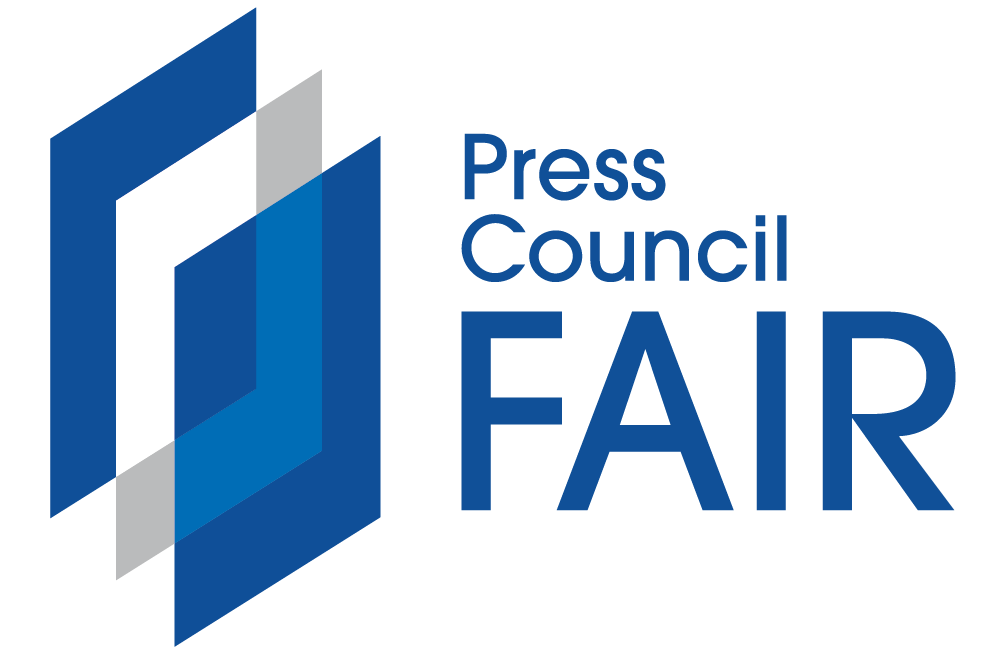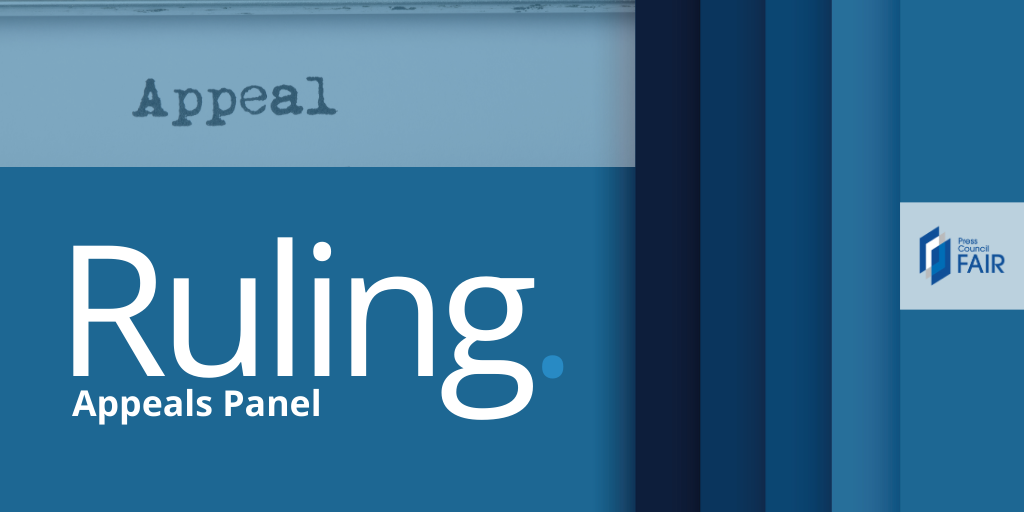Elaine Boardman vs. Middelburg Obsever
SUMMARY
The headline to the story in dispute read, Video: Policeman crushed – WARNING: Graphic images (published on 3 November 2014).
This ruling by Press Ombud Johan Retief was based on the Press Code that was in effect before 30 September 2022.
The story was about a policeman who had been struck by a rolling car after a collision. A man was photographed lying on his back in the street, and he reportedly died later in hospital. Some other pictures were also published. On scrolling down, one could click on a link to a video that showed how bystanders freed a man from under a car.
Elaine Boardman complained that the publication of the video and photographs of a deceased man was inconsiderate, insensitive and in poor taste.
Retief stipulated some general considerations regarding the use of such pictures. These included that the press should be wary of identifying dead people or those who are in the process of dying, as this could cause families and loved ones some serious, unnecessary harm; public interest played a huge role; consent of the family was preferable; and sensitive parts could be blocked out.
Regarding this case, the Ombud said the “warning” that the newspaper published was meaningless, as it was placed right underneath the headline – the public had no choice but to see the image.
Retief upheld the complaint about two pictures that showed parts of a person’s face as their families could have identified them. Middelburg Observer was reprimanded for publishing the picture of a dying man, without blocking out his head and the blood, and was directed to remove those pictures from its website, with a note of this finding.
The complaint about the other pictures were dismissed, as the Ombud said he did not believe that those pictures had added to the family’s trauma.
THE RULING ITSELF
This ruling is based on the written submissions of Ms Elaine Boardman and those of Tobie van den Bergh, editor of the Middelburg Observer.
Complaint
Boardman is complaining about photographs published on the website of the Middelburg Observer on 3 November 2014, headlined Video: Policeman crushed – WARNING: Graphic images.
She complains that the publication of the video and photographs of a deceased man is inconsiderate, insensitive and in poor taste.
The text
The story is about a policeman who was struck by a rolling car after a collision. The man was photographed lying on his back in the street, and he reportedly died later, in hospital.
This picture and four others are published in the story itself. On scrolling down, one may click on a video showing how bystanders freed a man from under a car.
The arguments
Boardman complains that the publication of the video and photographs of a deceased policeman is insensitive and in poor taste. She asks what consideration the Middelburg Observer gave to the man’s family, friends and colleagues, and argues that the newspaper had no respect for the dead. “What kind of memory should people have after seeing this?”
The newspaper replies that the:
- Middelburg area has been described as a traffic war zone (as statistics indicate);
- community is concerned about this state of affairs (for example, a motorcycle organization has taken the initiative to brief students and parents travelling on motorcycles in the area);
- incident in question is therefore a matter of “[great] public interest. The newspaper was under an obligation to report on the accident as fully and as prominently as possible”;
- public was warned in the headline, which was clarified in the introductory sentence; and
- video can only be seen once readers scroll down and click on the relevant button.
The editor also denies that it was his intention to disrespect the victims or their loved ones, and argues that the images are not degrading of the victims – one victim’s face was turned away from the camera, and the quality of the other pictures is so poor that the people could not have been identified (the same goes for the video).
Van den Bergh says he accepts that the media should not be allowed to publish images that desensitise readers to violence, brutality and suffering, or that are degrading to people. “It is our submission, however, that the images used by Middelburg Observer do not fall under any of these categories.”
Finally, the editor mentions three well-known “iconic” images of human suffering – Hector Pieterson, a Vietnamese girl and members of the Afrikaner Weerstandsbeweging (AWB).
Analysis
The matter was clearly in the public interest. The question, therefore, is not whether Middelburg Observer should have covered the incident, but rather how it should have presented it.
Before adjudicating on the five pictures and the video, here are some general observations:
- The press should be wary of identifying dead people or those who are in the process of dying, as this may cause families and loved-ones some serious, unnecessary harm;
- A person may be identified only if it is in the overriding public interest (such as when Prime Minister Hendrik Verwoerd was killed in Parliament, or when members of the AWB were killed in a botched attempt at a coup);
- It is good policy to obtain the consent of the family before identifying a dead person;
- If it is in the public interest to cover such a tragic event, it normally is better to block out the face of the deceased, to use a small picture, and maybe also in black and white (especially if there is blood);
- There is a difference between publishing a picture of a dead person and showing someone who has been injured; and
- The publication of dead bodies in some other country is not likely to cause loved-ones unnecessary harm (unless they are South Africans, in which case they may be recognised) – but this would be a weak argument.
The first two pictures
These colour images are used over the entire width of the story. The first shows bystanders trying to free a man who was trapped under a car (person A), and another man lying on his back (person B); the second picture was taken seconds later when A was freed. Both were seriously injured (blood was flowing from both victims). Person A reportedly died shortly after his admission to hospital.
Firstly, the “warning” in the headline: It makes little sense to publish a warning, only to publish right underneath the headline and the introductory sentence the picture about which the public has been warned – the public had no choice but to see the image.
The warning, therefore, is meaningless.
Now, the matter of identification: B can easily be identified, especially in the first picture, as a part of his face as well as the side of his face can clearly be seen. He did not die, though – which means the trauma caused to his family by the publication of his picture is reduced.
It is more difficult to identify A, as his head is turned away from the camera and he is further away from the camera. However, his family would surely have identified him. It would have been a different matter if at least his head and the blood flowing from it had been blocked out. I am convinced that this picture has most probably exacerbated the family’s trauma.
The other three pictures
These images are used much smaller, and the injured could not be clearly identified. I do not believe that these pictures have added to the family’s trauma, given the publication of the first two pictures.
The video
I take into account the fact that the public (and the family) had a choice to click on the video, and that A is even less identifiable on the clip.
Finding
The first two pictures
The complaint about these pictures is upheld as far as Person A is concerned. This is in breach of Section 11 of the Press Code that states: “Due care and responsibility shall be exercised by the press with regard to the presentation of…suffering.”
The other three pictures
This part of the complaint is dismissed.
The video
This part of the complaint is dismissed.
Sanction
Middelburg Observer is reprimanded for publishing the picture of a dying man, without blocking out his head and the blood, and is directed to remove the first two pictures from its website, with a note of this finding.
Appeal
Our Complaints Procedures lay down that within seven working days of receipt of this decision, either party may apply for leave to appeal to the Chairperson of the SA Press Adjudication Panel, Judge Bernard Ngoepe, fully setting out the grounds of appeal. He can be contacted at [email protected].
Johan Retief
Press Ombudsman


